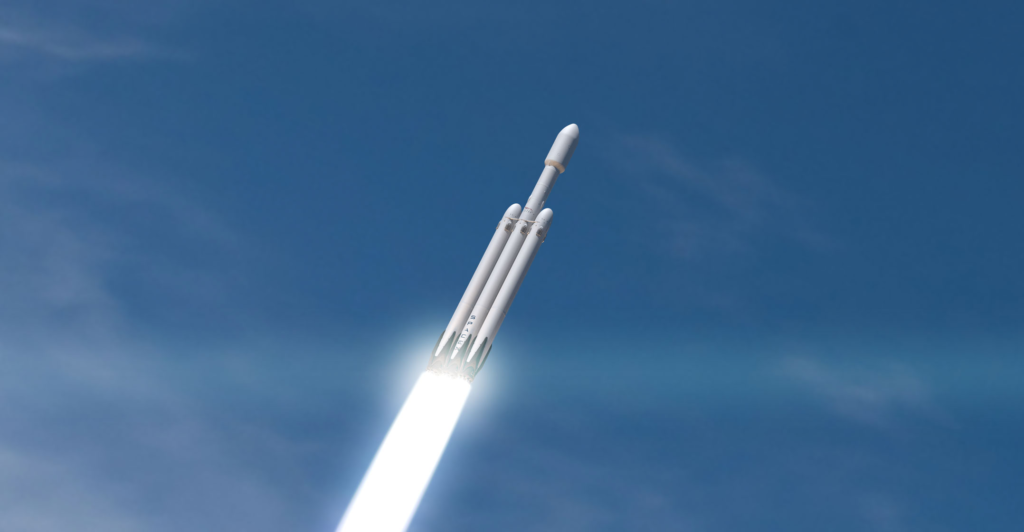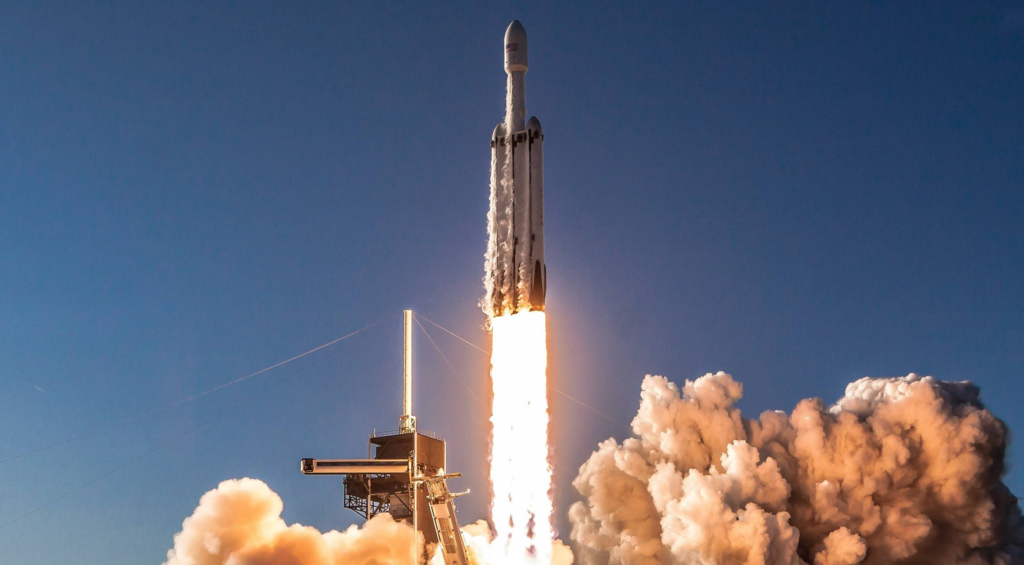
Falcon Heavy’s Next Launch Is Right Around The Corner
Earlier this month Falcon Heavy lifted off for the first time in over 3 years. The launch went perfectly and once again we saw a successful simultaneous booster landing. However, what’s arguably even more exciting than this most recent launch, is the heavy lift launch vehicle’s upcoming packed full schedule. Recently we were provided updates about Falcon Heavy’s next flight, and some of the details of this mission.
Specifically, just a few days ago we learned that Viasat is now targeting January of next year just over one month away. Currently, the payload is being inspected after some previous ground tests not long ago. This mission is for Viasat and is expected to launch the ViaSat-3 satellite along with a secondary payload from Arcturus.
While this launch was initially scheduled to happen years ago in 2019, Viasat experienced issues with the supply chain and was not ready. This combined with a few delays with SpaceX and the original mission scheduled quite a while ago never happened, until now. Here I will go more in-depth into this upcoming launch, Falcon Heavy’s full schedule, what to expect in the near future, and more.
Launch In January

Over the last two weeks, a few different developments have been made regarding Falcon Heavy’s next launch. Not long ago the ViaSat-3 satellite was scheduled to lift off this December just one month away. However, Viasat said earlier this month that its first ViaSat-3 broadband satellite will not be ready to launch on SpaceX’s Falcon Heavy rocket this year. Instead, the company now expects the satellite will be shipped from Boeing’s manufacturing facilities in California to SpaceX’s launchpad in Florida soon enough to facilitate an early 2023 launch. In addition, ViaSat-3’s deployable subsystems are currently being inspected and reintegrated into the launch configuration following successful environmental and ground tests. Mark Dankberg, the CEO of Viasat commented that they are working with SpaceX to target a launch with Falcon Heavy in the early part of next year’s first quarter and that it depends on the timing of some U.S. national priority launches.
Based on all this information, we can expect the next Falcon Heavy launch in January of next year just over one month away. While there are a few different aspects of this mission still in the air, this timeframe seems realistic for both SpaceX and Viasat. In relation to this launch, a few years ago, Falcon Heavy was slated to launch the Viasat-2 satellite, but due to delays, an Ariane 5 launch vehicle was used instead. While not ideal, Viasat maintained the launch option and will launch its next Ka-band satellite, which will serve either the Asia-Pacific, Europe, Middle East, Africa, or Americas regions, using Falcon Heavy. During this mission, the upper stage of Falcon Heavy will deploy the satellite into a near-geosynchronous orbit that will include a coasting stage several hours long between burns. As partially mentioned prior, Arcturus was added as an independent secondary payload in late September 2021.
As far as the payload itself, ViaSat-3 is planned to be a global satellite constellation consisting of three high-capacity Ka-band satellites that are expected to increase the coverage and capacity of the company’s network with the goal to bring high-quality, low-cost connectivity where it’s needed most. Each ViaSat-3 satellite is expected to have more than 1 Terabit per second (Tbps) of throughput capacity, making them the highest-capacity broadband satellites ever launched. The idea is, from air to land to sea, ViaSat-3 satellites will serve homes, businesses, communities, airlines, business jets, and enterprises such as energy, militaries, and governments. As each satellite launches, service in that region will “turn on.”
Falcon Heavy’s Schedule

Now that we know more about Falcon Heavy’s next launch and the updates surrounding it, we can take a closer look at some of the other missions scheduled not far away and what makes this rocket so special. To put it in perspective, as of right now, there are at least 10 missions by the end of 2024 either scheduled or planned to happen using the Falcon Heavy. Quite an increase in expected launch cadence from the multiple years without a launch. Besides the ViaSat mission I highlighted prior, planned for January of next year, the U.S. Space Force has another launch scheduled. Named USSF-67, this is a similar mission to the one we watched earlier this month with a price tag of $317 million. Meant to be the first SpaceX launch of the Phase 2 USAF contract, likely to be on a Falcon Heavy with an increased fairing size, which will use three new boosters, with the center core in an expendable configuration (no grid fins or landing gear). Not to mention both side-boosters will be targeting a simultaneous landing on droneships Just Read The Instructions and A Shortfall Of Gravitas, as the mission requirements are similar to that of the USSF-44 mission.
Some of the other missions that could happen include another launch in January, then April, October, and into 2024. It’s possible that in October of 2024 Falcon Heavy will help NASA launch the Europa Clipper. Specifically, Europa Clipper will conduct a detailed survey of Europa and use a sophisticated suite of science instruments to investigate whether the icy moon has conditions suitable for life. Key mission objectives are to produce high-resolution images of Europa’s surface, determine its composition, look for signs of recent or ongoing geological activity, measure the thickness of the moon’s icy shell, search for subsurface lakes, and determine the depth and salinity of Europa’s ocean. The mission will fly past Mars and Earth before arriving at Jupiter in April 2030. Back in 2021 NASA awarded this launch to SpaceX and Falcon Heavy for a price of around $178 million. Just a few examples of exciting upcoming missions we could see happen.
Shifting our focus to the rocket, SpaceX offers a family of launch vehicles that works to improve launch reliability and increases access to space. The company was founded on the philosophy that simplicity, reliability, and cost effectiveness are closely connected. They point out that they approach all elements of launch services with a focus on simplicity to both increase reliability and lower cost. Three cores make up the first stage of Falcon Heavy. The side cores, or boosters, are connected on the nosecone, the interstage, and on the octaweb. Shortly after liftoff, the center core engines are throttled down. After the side cores separate, the center core engines throttle back up to full thrust. Falcon Heavy’s first stage incorporates 27 Merlin engines across three aluminum-lithium alloy rocket cores containing liquid oxygen and rocket-grade kerosene (RP-1) propellant. Falcon Heavy generates more than 5 million pounds of thrust at liftoff.
At the upper stage, the Merlin Vacuum features a larger exhaust section and a significantly larger expansion nozzle to maximize the engine’s efficiency in the vacuum of space. Its combustion chamber is regeneratively cooled, while the expansion nozzle is radiatively cooled. At full power, the Merlin Vacuum engine operates with the greatest efficiency ever for an American-made hydrocarbon rocket engine. Falcon Heavy draws upon Falcon 9’s proven design, which minimizes stage separation events and maximizes reliability. The second-stage Merlin Vacuum Engine delivers the rocket’s payload to orbit after the main engines cut off and the first-stage cores separate. At the very top, made of a carbon composite material, the fairing protects satellites on their way to orbit. SpaceX is recovering fairing for reuse on future missions.
The first-stage propellant tank walls of the Falcon vehicles are made from an aluminum lithium alloy. Tanks are manufactured using friction stir welding—the highest strength and most reliable welding technique available. A common dome separates the LOX and RP-1 tanks, and a double-wall transfer tube carries LOX through the center of the RP-1 tank to the engine section. Four grid fins near the top of the first stage along with four deployable legs at the base are nominally flown to support recovery operations. While the design and structure are very important, so are the brains and internals of a rocket. Falcon avionics feature a flight-proven, three-string, fault-tolerant architecture that has been designed to human-rating requirements. Avionics include flight computers, Global Positioning System (GPS) receivers, inertial measurement units, SpaceX-designed and manufactured controllers for vehicle control (propulsion, valve, pressurization, separation and payload interfaces), a network backbone, S-band transmitters and a C-band transponder for range safety tracking. The S-band transmitters are used to transmit telemetry and video to the ground, from both the first and second stages, even after stage separation. All of which combines together to create one of the most powerful and interesting operational launch vehicles within the industry. With any luck, we can expect to see Falcon Heavy lift off quite a few more times in the coming months and years.
Conclusion
After over 3 years without a launch, earlier this month we watched the Falcon Heavy lift off once again and demonstrate a successful mission. Now a few weeks later SpaceX and various companies are preparing for the heavy lift launch vehicle’s next mission just over a month away. This joins a very busy schedule from now until at least the end of 2024. We will have to wait and see how it progresses and the impact it has on the space industry.
